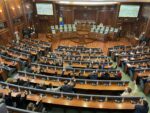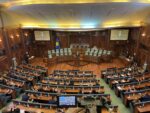Mass protests erupt across Serbia, with Ivana Stradner likening the movement to those against Slobodan Milošević. Could this mark the end of Aleksandar Vučić’s regime?
Massive protests have swept Serbia, as citizens voice their opposition to the regime of Aleksandar Vučić, drawing parallels to the uprisings against Slobodan Milošević in the 1990s. Analyst Ivana Stradner commented on the developments, calling it “the beginning of the end” for Vučić’s authoritarian leadership.
A Nation in Protest
Serbia’s unrest was sparked by public outrage over a tragic accident on November 1, 2024, at a railway station that claimed the lives of 15 people. The incident has fueled widespread anger, with demonstrators demanding accountability from the government.
Today’s protests included:
- A general strike with participation from private businesses, schools, libraries, theaters, clinics, and media outlets.
- Silent demonstrations by high school students, who paused for 15 minutes at major intersections in Belgrade.
- Solidarity marches in Subotica, Sombor, and Kraljevo, drawing thousands of participants.
At the University Clinical Center in Niš, healthcare workers joined the movement, voicing support for student demands.
Stradner: A Turning Point
Ivana Stradner, writing on X, compared the scale of these protests to the anti-Milošević demonstrations of the 1990s, stating, “It will take time, but this is the beginning of the end for Vučić’s authoritarian regime.”
Incidents and Tensions
The protests have not been without incident. In New Belgrade, a 26-year-old woman was struck by a car and rushed to emergency care, while the driver was promptly arrested by police.
Students have been a driving force behind the unrest, maintaining blockades at over 60 university faculties for more than two months. They’ve urged Serbian citizens to join the general strike, framing it as a collective act of civil disobedience and solidarity.
Broader Implications
The protests signal mounting dissatisfaction with Vučić’s leadership, as calls for accountability grow louder across all segments of society. Whether this movement will indeed mark the end of Vučić’s regime remains uncertain, but its scale and persistence suggest that change is on the horizon.







